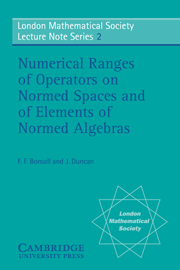CHAPTER 1 - Numerical range in unital normed algebras
Published online by Cambridge University Press: 05 June 2013
Summary
In a Banach algebra the spectrum of an element depends only on the algebra structure and not at all on the norm. The numerical range of an element of a normed algebra is a subset of the scalar field that reflects both the algebraic and the norm structure. We may regard it as giving information on the geometry of the normed algebra. In the case of a unital normed algebra, the numerical range of an element a is determined by the values of the given algebra-norm on the two-dimensional linear subspace spanned by a and the unit element.
In §2 we derive the elementary facts about the numerical range of an element of a unital normed algebra. We show in particular that the numerical range is a compact convex set. When the algebra is complete, the numerical range of an element contains the part of the spectrum that lies in the scalar field. We derive an important formula for the maximum of the real parts of numbers in the numerical range. We also consider the effect of computing the numerical range with respect to equivalent algebra-norms. Finally we introduce the notion of joint numerical range and indicate its relation with the joint spectrum.
In §3 we study the exponential function in a unital Banach algebra and give formulae, in terms of the exponential function, for the maximum of the real parts of numbers in the numerical range and in the spectrum of an element. This leads to the concept of a dissipative element in a unital Banach algebra.
- Type
- Chapter
- Information
- Publisher: Cambridge University PressPrint publication year: 1971



